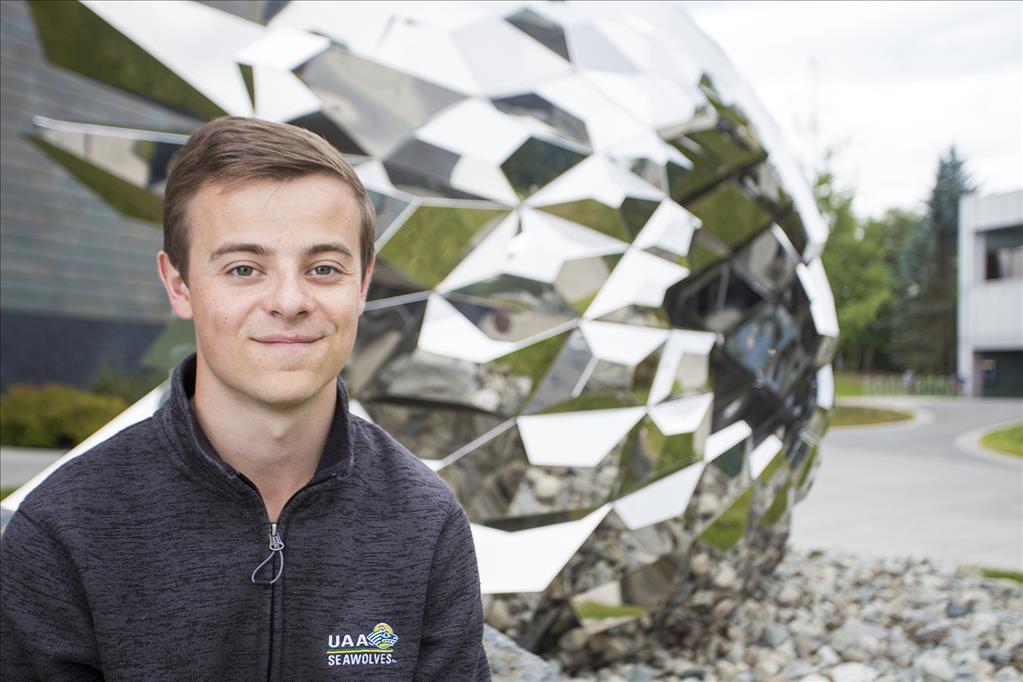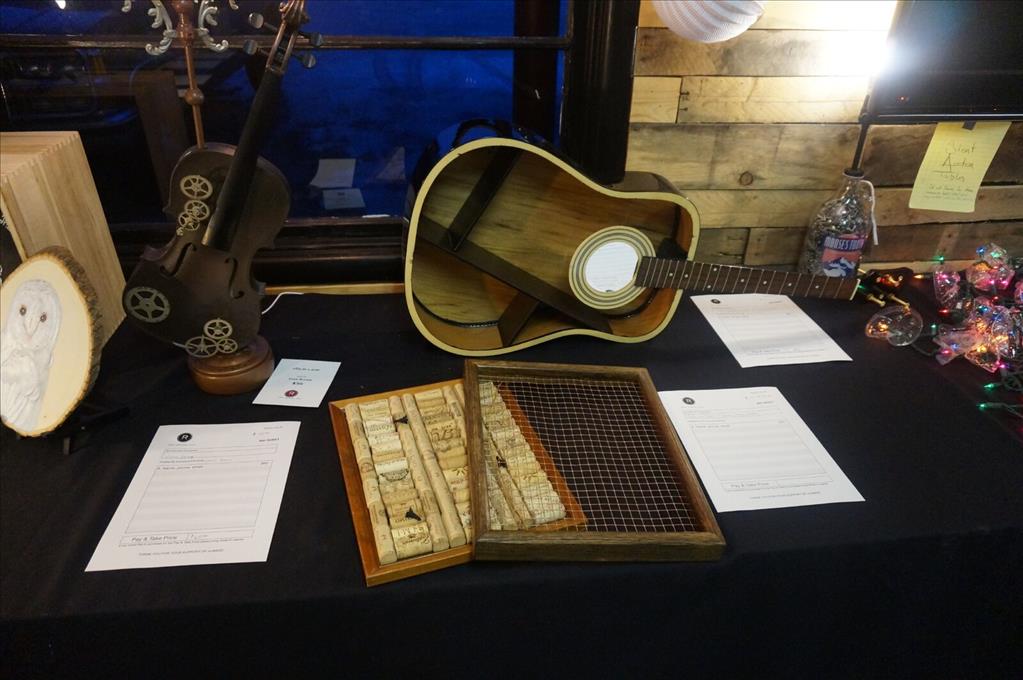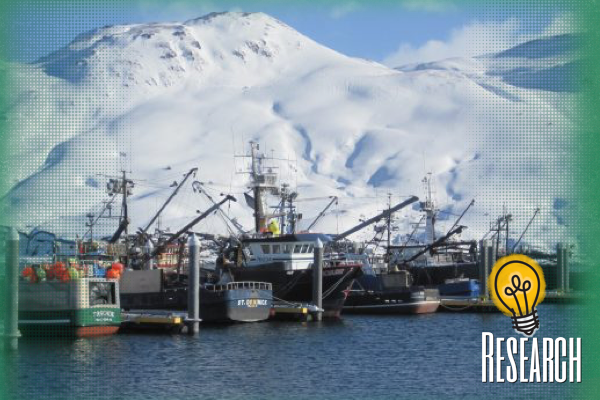Deeper understanding is goal of UAA Undergraduate Research & Discovery Symposium
by Tracy Kalytiak |
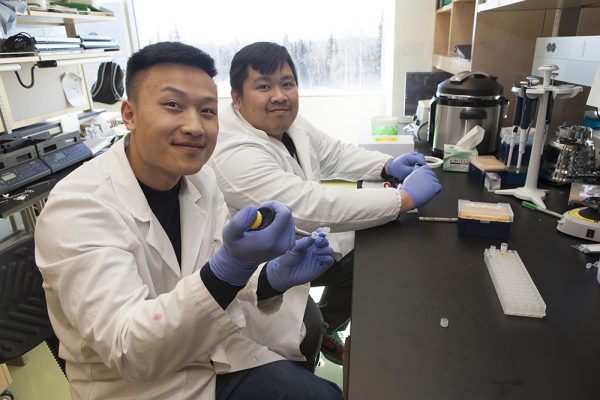
UAA natural sciences student Kou Thao, left, and chemistry major Dominic Mallari are taking part in the upcoming UAA Undergraduate Research & Discovery Symposium, April 17-21. Their Alaska Heart Institute-supported work focuses on whether capsaicin - the chemical responsible for giving spicy food its heat - relieves or worsens gastric cancer. (Photo by Philip Hall / University of Alaska Anchorage)
Perhaps you've heard how the chemical responsible for giving spicy food its fiery bite and pepper spray its incapacitating sting could help cure breast cancer. Or maybe you've read that the same chemical - capsaicin - does the opposite: generating carcinogens that play a role in gastric and other forms of cancer.
Kou Thao is trying to find the correct answer, because the topic hits very close to home.
"I love eating spice and come from an Asian background that loves spice," said Thao, a UAA natural sciences student. "I realized lots of people in many cultures love to eat spice, and research shows people who live in [those] particular areas seem to have a higher risk of gastric cancers. I thought it would be great to find out about it, see if there's any relationship of capsaicins, the consumption of capsaicins, with Epstein-Barr virus-positive gastric cancer cells."
Thao and his student colleague, Dominic Mallari, are working under the guidance of UAA's Dr. Holly Martinson, with support from the Alaska Heart Institute through the University Honors College. They are among dozens of undergraduate researchers presenting projects at the Honors College's upcoming UAA Undergraduate Research & Discovery Symposium, April 17-21.
The annual Symposium celebrates undergraduate research taking place throughout UAA and fosters scholarly discussion between students, faculty and the community.
"Students across the disciplines will be presenting," said UAA Professor Eric Murphy, director of the University Honors College's Office of Undergraduate Research and Scholarship (OURS). "We've supported 255 students since last spring in one form or another."
- A poster fair is taking place April 17-20, at the UAA/APU Consortium Library,
- Dr. Candace Lewis will deliver the keynote speech, Psychedelics as therapeutics: An old and new story, at 7 p.m., April 19, in Arts 150. Lewis is a post-doctoral scholar at the Translational Genomics Research Institute (TGen) at Arizona State University's Department of Psychology. A native of Wasilla, she earned her bachelor's degree in psychology from UAA in 2009. From 2010-2015, she pursued graduate studies at ASU on a Harry S. Truman Scholarship, earning both a Master of Arts and a doctorate in behavioral neuroscience. As a Fulbright Fellow, she studied advanced neuroimaging in Zurich, and, in 2015, was named a Bisgrove Scholar at ASU. Lewis hopes to help unravel the molecular mechanisms by which experiences can shape neurobiology and behavior. Her keynote address is free and open to the public.
"What's great with this keynote speaker is that she's a UAA graduate," Murphy said. "I think she's going to be a real model for our students."
- Research presentations will take place 9 a.m.-3 p.m., April 21. Presentation A will take place between 9:30 a.m.-noon, in Eugene Short Hall, Room 216; Presentation B is scheduled for 11:30 a.m.-2:45 p.m., Beatrice McDonald Hall, Room 239; Presentation C is scheduled for noon-1:30 p.m., Beatrice McDonald Hall, Room 235; Presentation D will take place from 12:15-2:45 p.m., in the Social Sciences Building, Room 224, and Presentation E is set for 1:45-2:45 p.m., in Rasmuson Hall, Room 316.
- Poster presentations will take place 3-4 p.m., April 21, in the ConocoPhillips Integrated Science Building atrium.
- An awards ceremony is set for 4-5 p.m., April 21, at a to-be-determined location.
The first Symposium took place in the mid 2000s: "We had nine students," Murphy said.
Student researchers are eligible to receive honors like the UAA Honors College Fran Ulmer Transformative Research Award, Alaska Heart Institute Biomedical Research Fellowships, the ISER Policy Research Award, the Undergraduate Research in the Community Award, Meissner Creativity Award in the Visual Arts, the Consortium Library Prize, OURS/Alaska INBRE Undergraduate Research Assistantship and other research grants and awards.
Another AHI awardee, in addition to Thao, is Priscilla Natcher, for her research into "natural killer" immunotherapy for eliminating latent HIV.
Undergraduate Research in the Community awardees include Crystal Dosser, for her "Dance and Virtual Reality through 360 Degrees"; Kasandra Saiki, for her analysis of glaciofluvial deposits in Portage Glacier Valley; Anna Stanczyk, for her research into the cause of the Pretty Rocks debris slide in Denali National Park; Sevy Sheppard won the ISER Policy Research Award.
Students who received undergraduate research grants included Stephen Kranich, Alexandra Busk, Jordyn Jones, Dominik Notz, Tequila Nunley, Nicholas Oliver, Wolfgang Olsson, Katinna Rodriguez Baisi, Victoria Vandersommen, Pierce Bateman, Crystal Dosser, Nina Lee, Sophie Leshan, Maria Lilly, Chelsea Parrocha, Show Wang, Kenyon Wright, Ralf Dagdag, Anthony Davis, William George, Dayana Lau, Khafani Amundson, Anna Bassler, Khulan Bazarvaani, Christine Brummer, Katrina Chertkow, David Clark, Kayla Craft, Lukas Easton, Jenna Gerrety, Kelsee Jordan, Kelly Mistry, Kate Moyers, Arielle Neithercoat, Nikki Roth, Amanda Sassi, Mary Sine, Madison Smith, Lisa Thayer, Joshua VanderMartin, Lee Wang, and Ciara Zervantian; Taran Haynes won a discovery grant.
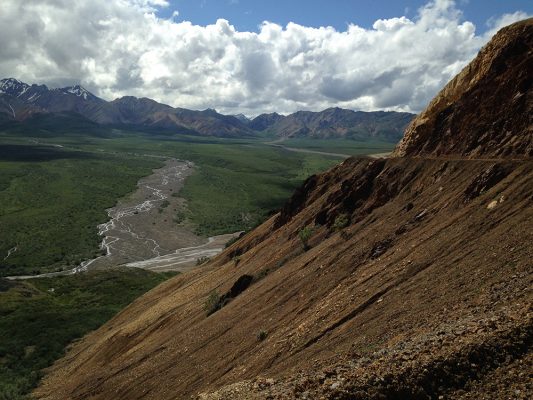
This was the view from UAA student Anna Stanczyk's research "classroom" last summer at Denali National Park's Polychrome Pass. Stanczyk's project is one of the undergraduate research efforts being showcased next week at the UAA Undergraduate Research & Discovery Symposium. (Photo provided by Anna Stanczyk)
New offerings, Murphy said, include the ConocoPhillips Arctic Science and Engineering Apprenticeship, which awards $5,000 to a student to work on a summer project with a faculty mentor. This grant begins this summer, he added.
And, the Ludwig Foundation and Anchorage Museum are partnering to offer students a chance to travel to Cuba to study art and dance as part of a "Resilient Communities in Transition" themed project. Caroline Streff won that opportunity.
"If this year goes well, I think this will be part of our regular suite of awards," Murphy said.
Opening the field of research is critical for students, Thao said.
"This research gives me an opportunity to deepen my understanding on a specific topic I'm interested in, something I do not get in regular classes," he explained. "I am hoping this project can initiate more research on pepper and gastric cancer in the future."
If capsaicin increases the risk of cancer, the researchers want to take action.
"I'd want to make people aware of it, maybe do more study with it," Mallari said.
Written by Tracy Kalytiak, University of Alaska Anchorage
 "Deeper understanding is goal of UAA Undergraduate Research & Discovery Symposium" is licensed under a Creative Commons Attribution-NonCommercial 4.0 International License.
"Deeper understanding is goal of UAA Undergraduate Research & Discovery Symposium" is licensed under a Creative Commons Attribution-NonCommercial 4.0 International License.










